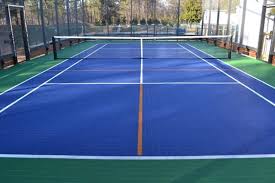Everything You Need to Know About Pickleball Court Installation

Have you ever thought about installing a pickleball court in your backyard or community space? Whether you’re a seasoned player or just getting started, having your own court can be a game-changer. Let’s dive into the essentials of pickleball court installation, breaking down the process into simple steps. You’ll be ready to enjoy this fast-growing sport in no time!
Introduction
Pickleball is a fun and easy-to-learn sport that combines elements of tennis, badminton, and ping-pong. It’s played with a paddle and a plastic ball with holes and can be enjoyed by people of all ages. As the sport grows in popularity, more people are looking to install their own courts to practice and play at their convenience.
Why Install a Pickleball Court?
Installing a pickleball court offers numerous benefits. It’s a great way to stay active, spend time with family and friends, and even boost property value. Plus, having a court nearby means you can play anytime without having to wait for an available public court.
Choosing the Right Location
Selecting the perfect spot for your court is crucial. Ideally, you want a flat area with enough space around it for players to move freely. Think about the orientation too; a north-south alignment minimizes sun glare. Ensure the ground is level and free from obstructions like trees or power lines.
Dimensions and Layout
A standard pickleball court measures 20 feet wide by 44 feet long, including the non-volley zone, also known as the kitchen. Make sure to plan for extra space around the court, about 10 feet on each end and 5 feet on the sides, for safety and comfort.
Surface Material Options
The surface material you choose can impact play quality and maintenance. Popular options include concrete, asphalt, and modular tiles. Concrete and asphalt are durable and provide a consistent playing surface, while modular tiles offer easy installation and good shock absorption.
Net and Post Installation
The net should be 36 inches high at the sidelines and 34 inches at the center. Installing sturdy posts that can withstand outdoor conditions is important. Some systems come with adjustable heights, which can be useful if you play different sports on the same court.
Painting the Court Lines
Use high-quality, outdoor paint to mark the court lines. The lines should be 2 inches wide, with clear, contrasting colors to ensure visibility. Make sure the paint is slip-resistant to prevent accidents during play.
Lighting Considerations
If you plan to play in the evenings, proper lighting is essential. LED lights are a popular choice due to their efficiency and brightness. Position the lights to minimize shadows and ensure the entire court is evenly lit.
Fencing and Windbreaks
Installing a fence around your court can keep balls contained and enhance safety. Windbreaks can be particularly useful in windy areas, as they help maintain consistent ball movement and improve the playing experience.
Maintenance Tips
Regular maintenance keeps your court in top condition. Clean the surface regularly, check for cracks, and repaint lines as needed. If using a modular tile surface, inspect for any loose tiles and secure them promptly.
Safety Measures
Ensure your court is safe for all players. This includes using non-slip paint, installing padding on fences, and keeping the area around the court clear of debris. Always have first-aid supplies nearby in case of accidents.
Cost Breakdown
The cost of installing a pickleball court can vary widely based on materials, labor, and additional features like lighting and fencing. On average, expect to spend between $10,000 and $30,000. Budgeting for unexpected expenses is also a good idea.
DIY vs Professional Installation
Deciding whether to install the court yourself or hire professionals depends on your budget and skills. A DIY approach can save money but requires time and effort. Professional installation ensures a high-quality result and can save you from potential mistakes.
Conclusion
Installing a pickleball court is a rewarding project that can enhance your lifestyle and property. By following these steps and considering your options carefully, you’ll be well on your way to enjoying countless hours of pickleball fun right at home.
FAQs
1. What is the best surface for a pickleball court?
Concrete and asphalt are popular choices for their durability and consistent playing surface. Modular tiles are also a good option for easy installation and shock absorption.
2. How much space do I need for a pickleball court?
A standard court is 20 feet by 44 feet, but you should plan for additional space around the court, approximately 10 feet on each end and 5 feet on the sides.
3. Can I install a pickleball court myself?
Yes, a DIY installation is possible if you have the necessary skills and tools. However, hiring professionals can ensure a higher quality and faster installation.
4. How do I maintain a pickleball court?
Regularly clean the surface, check for cracks, and repaint lines as needed. Inspect modular tiles for any looseness and secure them promptly.
5. What are the lighting requirements for a pickleball court?
LED lights are recommended for their efficiency and brightness. Ensure the court is evenly lit with minimal shadows for the best playing experience.



